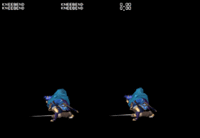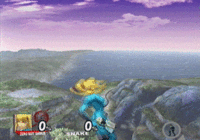Auto-canceling is the act of landing during the beginning or ending frames of an aerial attack and circumventing the landing lag that would have occurred had the character landed in the middle. Auto-canceling an attack produces no more landing lag than a regular landing, while landing during the middle of an aerial attack almost always results in a significant delay. Most aerial attacks can be auto-cancelled both during the first few frames or the last few frames, though some cannot be auto-cancelled at the start, at the end, or even both. Every attack has a specific auto-cancelling window. Auto-canceling can be very beneficial to players using characters with laggy aerial attacks, as this can reduce the amount of landing lag produced, and create more time for the character to act, potentially avoiding punishment that could have been made if the player had not auto-cancelled. Precise auto-canceling of aerials is frequently needed for performing followups and combos while leaving no time for the opponent to react and escape.
Trivia
- The forward airs of Donkey Kong in Melee and Donkey Kong and Ganondorf in Brawl cannot be auto-cancelled in the ending frames. By looking at the coding of the moves, it can be seen that they were intended to be, and they cannot due to a minor error of using the wrong type of timing function.

